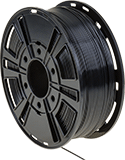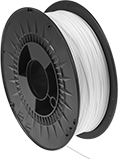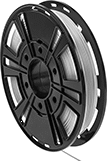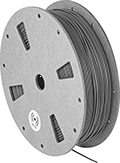Wear-Resistant Nylon 3D Printer Filaments

Print tough, long-lasting parts that won’t scratch or wear out from constant motion and friction, such as gears and washers. You can even tap or drill the parts without them cracking or shattering.
Use these filaments with fused filament fabrication (FFF) printers. Because of their relatively high melting point, a heated printer bed is recommended. These filaments also emit fumes when printing, so it’s best to use them in an enclosed printer or to remove the fumes with a fume exhauster. Store them in a sealed container with a desiccant so they don’t absorb moisture in the air, which can make them unusable.
Nylon 6/66 filaments are the strongest nylon filaments without a filler, but may warp while cooling.
Nylon 6/69 filaments stand up to chemicals for use in a variety of chemical processing applications. They’re also FDA Compliant 21 CFR 177.1395 and FDA Compliant 21 CFR 177.1500, so they can be used to produce parts that are intended for processing, handling, and packaging food and beverages.
Carbon-fiber-filled nylon filaments make rigid parts that are difficult to bend and break. Their parts can also be threaded and machined more easily than the same filaments without any filler. However, they’re abrasive, so only use them with abrasion-resistant nozzles.
Fiberglass-filled nylon filaments make strong parts that are less prone to warping or shrinking than the same filaments without any filler. However, they’re abrasive, so only use them with abrasion-resistant nozzles.
Tensile strength is the best measure of a filament's overall strength. Similar to the stress applied on a rope during a game of tug-of-war, it's the amount of pulling force a material can handle before breaking. A higher rating means a stronger filament. A tensile strength of 5,000 psi and above is considered good; 12,000 psi and above is excellent.
Maximum exposure temperature is the point at which a printed part will begin to deform. Above this temperature, your printed parts will start to lose structural integrity.
Spool | ||||||||||||
|---|---|---|---|---|---|---|---|---|---|---|---|---|
| Dia., mm | Printing Temp. | For Printer Bed Temp. | Tensile Strength | Hardness | Max. Exposure Temp. | Specifications Met | For Min. Nozzle Opening Dia., mm | Dia., mm | Dp., mm | Wt., g | Each | |
Nylon Plastic 6/66 | ||||||||||||
Black | ||||||||||||
| 1.75 | 255° to 275° C 491° to 527° F | 60° to 70° C 140° to 158° F | 8,700 psi (Good) | Durometer 60D (Medium) | 85° C 185° F | __ | 0.25 | 200 | 75 | 750 | 000000 | 000000 |
Nylon Plastic 6/69 | ||||||||||||
Black | ||||||||||||
| 2.85 | 250° to 255° C 482° to 491° F | 30° to 65° C 86° to 149° F | 8,100 psi (Good) | Not Rated | 82° C 180° F | FDA Compliant 21 CFR 177.1395, FDA Compliant 21 CFR 177.1500 | 0.2 | 200 | 70 | 1,000 | 0000000 | 00000 |
Off-White | ||||||||||||
| 2.85 | 250° to 255° C 482° to 491° F | 30° to 65° C 86° to 149° F | 8,100 psi (Good) | Not Rated | 82° C 180° F | FDA Compliant 21 CFR 177.1395, FDA Compliant 21 CFR 177.1500 | 0.2 | 200 | 70 | 1,000 | 0000000 | 00000 |
Carbon Fiber-Filled Nylon Plastic | ||||||||||||
Black | ||||||||||||
| 1.75 | 280° to 300° C 535° to 570° F | 50° C 122° F | 15,225 psi (Excellent) | Not Rated | 125° C 257° F | __ | 0.4 | 200 | 65 | 500 | 000000 | 00000 |
Fiberglass-Filled Nylon Plastic 6 | ||||||||||||
Gray | ||||||||||||
| 1.75 | 280° to 300° C 536° to 572° F | 25° to 50° C 77° to 122° F | 11,950 psi (Good) | Not Rated | 70° C 158° F | __ | 0.4 | 250 | 117 | 2,000 | 0000000 | 000000 |
| 2.85 | 280° to 300° C 536° to 572° F | 25° to 50° C 77° to 122° F | 11,950 psi (Good) | Not Rated | 70° C 158° F | __ | 0.4 | 250 | 117 | 2,000 | 0000000 | 000000 |
Slippery Wear-Resistant 3D Printer Filaments
 | Beige |
White |
Often used to make bearings, worm gears, and other smooth moving parts, these filaments create parts that won’t wear out from constant motion. They're a slippery thermoplastic blend, so they have better wear resistance and lower friction than other filaments.
Print these filaments on a fused filament fabrication (FFF) printer. Because of their high melting point, a heated printer bed is recommended since the parts will cool too quickly and warp without it. You must use an enclosed printer or fume exhauster while printing these filaments. Store them in a sealed container with a desiccant, or use a dehumidifying cabinet, since moisture in the air can degrade their printing quality.
Maximum exposure temperature is the point at which a printed part will begin to deform. Above this temperature, your printed parts will start to lose structural integrity.
Spool | |||||||||||
|---|---|---|---|---|---|---|---|---|---|---|---|
| Dia., mm | Printing Temp. | For Printer Bed Temp. | Tensile Strength | Hardness | Max. Exposure Temp. | For Min. Nozzle Opening Dia., mm | Dia., mm | Dp., mm | Wt., g | Each | |
Thermoplastic Blend | |||||||||||
Beige | |||||||||||
| 1.75 | 260° to 280° C 500° to 536° F | 100° to 130° C 212° to 266° F | Not Rated | Durometer 66D (Medium) | 120° C 248° F | 0.4 | 205 | 70 | 750 | 000000 | 0000000 |
| 2.85 | 260° to 280° C 500° to 536° F | 100° to 130° C 212° to 266° F | Not Rated | Durometer 66D (Medium) | 120° C 248° F | 0.4 | 205 | 70 | 750 | 0000000 | 000000 |
White | |||||||||||
| 1.75 | 240° to 250° C 464° to 482° F | 20° to 60° C 68° to 140° F | Not Rated | Durometer 62D (Medium) | 65° C 149° F | 0.4 | 205 | 70 | 750 | 0000000 | 00000 |
| 2.85 | 240° to 250° C 464° to 482° F | 20° to 60° C 68° to 140° F | Not Rated | Durometer 62D (Medium) | 65° C 149° F | 0.4 | 205 | 70 | 750 | 0000000 | 00000 |
Ultra-Strength High-Temperature PAEK 3D Printer Filaments

Parts made from these PAEK filaments, a family of materials that includes PEEK and PEKK, remain strong in high temperatures and hold up to wear from repeated use. They don’t degrade when exposed to most chemicals, so they’re often used to print parts for demanding chemical processing applications. Print these filaments on a fused filament fabrication (FFF) 3D printer. Because of their high melting point, you'll need an all-metal extruder and heated printer bed to reach their minimum printing temperature. Without the heated printer bed, parts will cool too quickly and warp.
Fiberglass-filled PEEK filaments make stronger parts that are less likely to warp and shrink than unfilled PEEK filaments. Since they’re abrasive, you should only use them with an abrasion-resistant nozzle.
Tensile strength is the best measure of a filament's overall strength. Similar to the stress applied on a rope during a game of tug-of-war, it's the amount of pulling force a material can handle before breaking. A higher rating means a stronger filament. A tensile strength of 5,000 psi and above is considered good; 12,000 psi and above is excellent.
Maximum exposure temperature is the point at which a printed part will begin to deform. Above this temperature, your printed parts will start to lose structural integrity.
Annealing is the process of heating prints to a specific annealing temperature and then slowly allowing them to cool. This makes the finished print harder, stronger, and better at resisting heat. Maximum temperature after annealing replaces the maximum exposure temperature once this process has been completed.
Spool | |||||||||||||
|---|---|---|---|---|---|---|---|---|---|---|---|---|---|
| Dia., mm | Printing Temp. | For Printer Bed Temp. | Tensile Strength | Max. Exposure Temp. | Max. Annealing Temp. | Max. Temp. After Annealing | For Min. Nozzle Dia., mm | Dia., mm | Dp., mm | Wt., g | Color | Each | |
PEEK Plastic | |||||||||||||
| 1.75 | 375° to 410° C 707° to 770° F | 130° to 145° C 266° to 293° F | 14,500 psi (Excellent) | 140° C 284° F | 140° C 284° F | 230° C 446° F | 0.4 | 195 | 40 | 500 | Opaque Beige | 0000000 | 0000000 |
Fiberglass-Filled PEEK Plastic | |||||||||||||
| 1.75 | 375° to 410° C 707° to 770° F | 130° to 145° C 266° to 293° F | 13,050 psi (Excellent) | 260° C 500° F | 140° C 284° F | 315° C 599° F | 0.4 | 195 | 40 | 500 | Opaque Beige | 0000000 | 000000 |
Dremel 3D Printer Filaments

Build parts and prototypes from these filaments using Dremel fused filament fabrication (FFF) 3D printers. An RFID tag on the spool communicates with your printer, automatically adjusting it to the correct temperature and print speed for the filament material and notifying you when the filament is running out.
Nylon resists scratches and wear, and is often used to create parts that encounter constant friction such as gears or bearings. Nylon parts also won’t crack or shatter when they’re drilled or tapped. Exposure to humidity makes these filaments brittle and unusable, so they need to be stored in a sealed container with a desiccant. Like ECO-ABS, parts can warp during cooling and need a heated printer bed. Make sure your printer is connected to a ventilation system, as nylon emits fumes during printing.
Tensile strength is the best measure of a filament's overall strength. Similar to the stress applied on a rope during a game of tug-of-war, it's the amount of pulling force a material can handle before breaking. A higher rating means a stronger filament. A tensile strength of 5,000 psi and above is considered good; 12,000 psi and above is excellent.
Maximum exposure temperature is the point at which a printed part will begin to deform. Above this temperature, your printed parts will start to lose structural integrity.
Spool | ||||||||||||
|---|---|---|---|---|---|---|---|---|---|---|---|---|
| Manufacturer Model No. | Dia., mm | Printing Temp. | For Printer Bed Temp. | Tensile Strength | Max. Exposure Temp. | For Min. Nozzle Opening Dia., mm | Dia., mm | Dp., mm | Wt., g | Color | Each | |
Nylon Plastic | ||||||||||||
| DF45-NYP-B | 1.75 | 230° to 250° C 446° to 482° F | 80° C 176° F | 7,540 psi (Good) | 155° C 311° F | 0.4 | 180 | 55 | 500 | Black | 0000000 | 000000 |

























